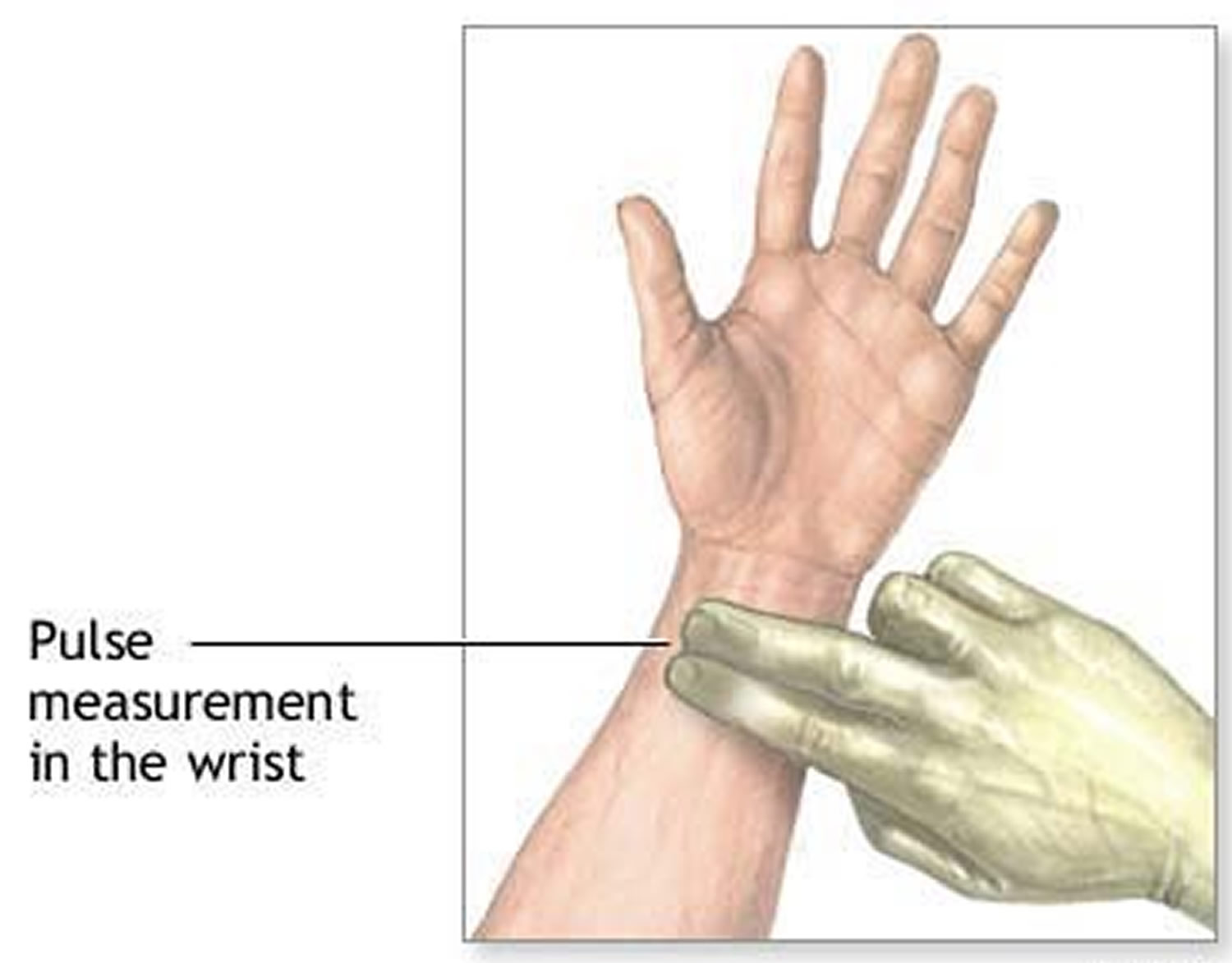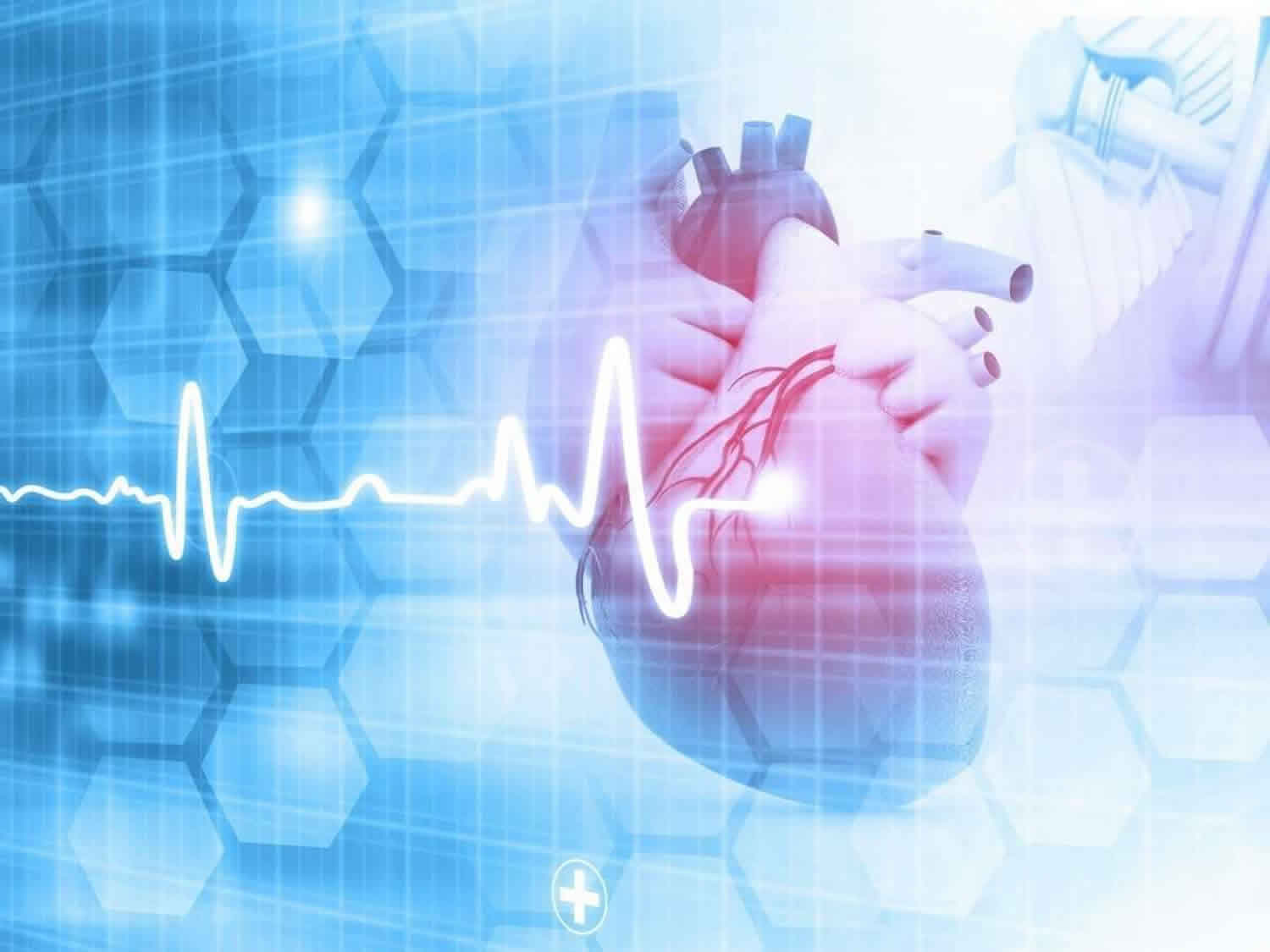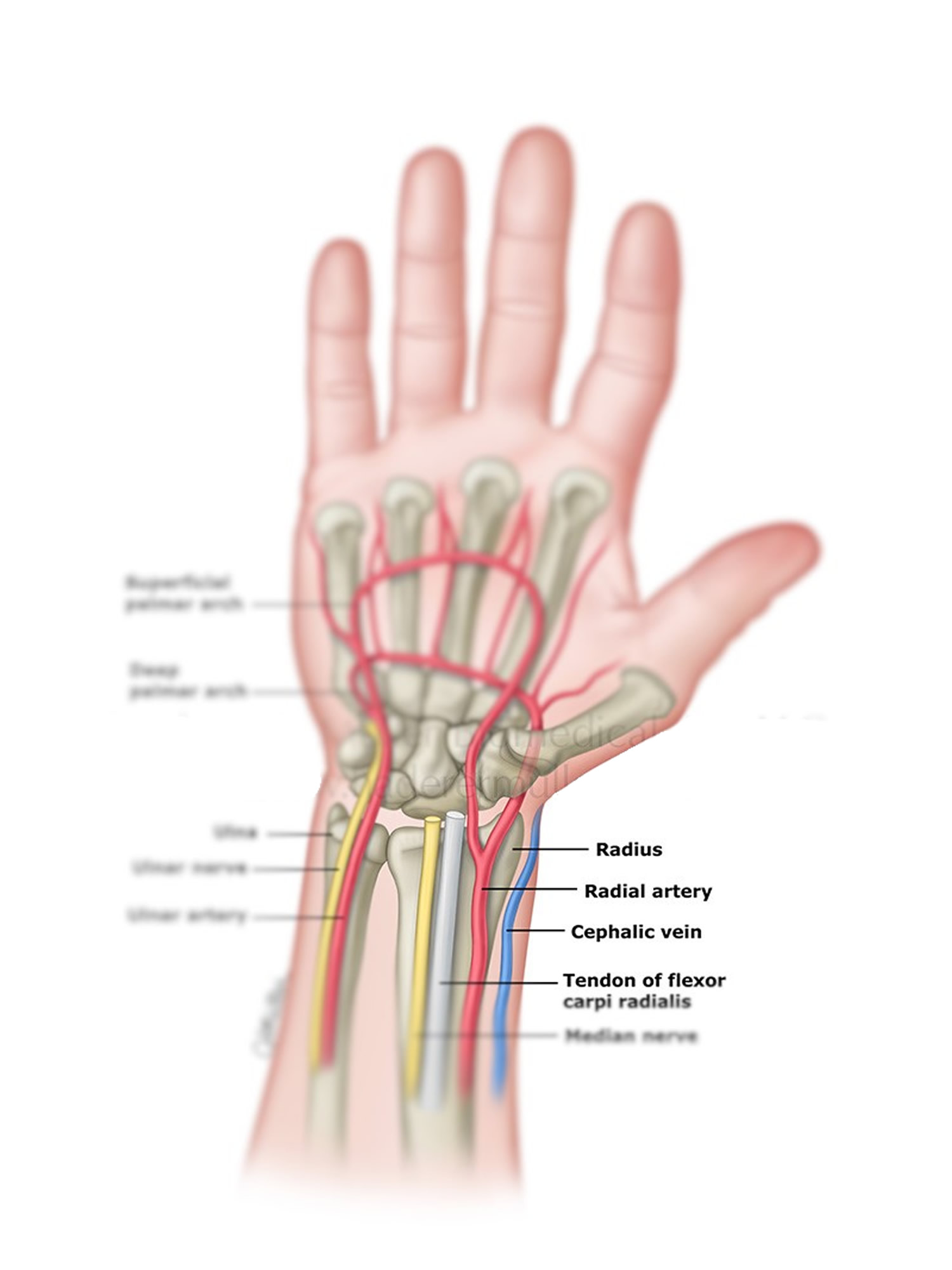Normal heart rate
Your heart rate or pulse, is the number of times your heart beats per minute (bpm). Normal heart rate varies from person to person. A healthy heart is not a metronome. The oscillations of a healthy heart are complex and constantly changing, which allow the cardiovascular system to rapidly adjust to sudden physical and psychological challenges to homeostasis 1. A healthy heart’s beat-to-beat fluctuations are best described by mathematical chaos 2. Your resting heart rate is the heart pumping the lowest amount of blood to supply the oxygen your body’s needs because you’re not exercising 3. For most healthy adult women and men, if you’re sitting or lying and you’re calm, relaxed and aren’t ill, your resting heart rate is normally between 60 (beats per minute) and 100 (beats per minute) 3.
According to the National Institute of Health, the average resting heart rate:
- for children 10 years and older, and adults (including seniors) is 60 – 100 beats per minute
- for well-trained athletes is 40 – 60 beats per minute.
But a heart rate lower than 60 doesn’t necessarily signal a medical problem. It could be the result of taking a drug such as a beta blocker. A lower heart rate is also common for people who get a lot of physical activity or are very athletic. Active people often have a lower resting heart rate (as low as 40) because their heart muscle is in better condition and doesn’t need to work as hard to maintain a steady beat. A low or moderate amount of physical activity doesn’t usually change the resting pulse much. As you age, changes in the rate and regularity of your pulse can change and may signify a heart condition or other condition that needs to be addressed.
Other Factors that can affect your heart rate
- Air temperature: When temperatures (and the humidity) soar, the heart pumps a little more blood, so your pulse rate may increase, but usually no more than five to 10 beats a minute.
- Body position: Resting, sitting or standing, your pulse is usually the same. Sometimes as you stand for the first 15 to 20 seconds, your pulse may go up a little bit, but after a couple of minutes it should settle down.
- Emotions: If you’re stressed, anxious or “extraordinarily happy or sad” your emotions can raise your pulse.
- Body size: Body size usually doesn’t change pulse. If you’re very obese, you might see a higher resting pulse than normal, but usually not more than 100.
- Medication use: Medications that block your adrenaline (beta blockers) tend to slow your pulse, while too much thyroid medication or too high of a dosage will raise it.
- Energy drinks.
- Caffeine in beverages and foods.
A 2013 study published in the journal Heart of nearly 3,000 men in Denmark showed the risk of death increased by 16% for every 10 beats per minute increase in resting heart rate 4. A study from the Women’s Health Initiative published in 2009 examined the relationship between resting heart rate and heart attacks and strokes in 129,135 postmenopausal women 5. The report from the Women’s Health Initiative indicated that a resting heart rate at the low end of that spectrum may offer some protection against heart attacks 5. When Women’s Health Initiative researchers examined data on 129,135 postmenopausal women, they found that those with the highest resting heart rates—more than 76 beats per minute—were 26% more likely to have a heart attack or die from one than those with the lowest resting heart rates—62 beats per minute or less 5. If your resting heart rate is consistently above 80 beats per minute, you might want to talk to your doctor about how your heart rate and other personal factors influence your risk for cardiovascular disease.
In the Women’s Health Initiative study the resting heart rate of postmenopausal women subjects was measured by taking their pulse at the wrist after they had sat quietly for five minutes. Physical activity, depression and anxiety, alcohol and caffeine use, hypertension, smoking, diabetes, and other factors were assessed by questionnaires and rating scales. During the nearly eight years of the study, 2,281 women suffered a heart attack or coronary death, and 1,877 had a stroke 5. Women with the highest resting heart rates (more than 76 beats per minute) were 26% more likely to have a heart attack or die from one than those with the lowest resting heart rates (62 beats per minute or less). This correlation held regardless of race or ethnicity and was independent of diabetes, hypertension, and unfavorable cholesterol levels. Resting heart rate was not related to the risk of stroke 5. According to the authors, although a resting heart rate above 76 may not be as powerful a predictor of heart problems as factors such as smoking, diabetes, or cholesterol levels, it’s still a useful indicator — a tip-off that lifestyle changes such as increased physical activity and stress reduction may be in order 5. Both regular exercise and relaxation techniques such as meditation and tai chi can help lower activity in the autonomic nervous system, which controls heart rate.
Is resting heart rate different by age?
For most of adults, between 60 and 100 beats per minute (bpm) is normal 3. Your heart rate can be affected by factors like stress, anxiety, hormones, medication, and how physically active you are. An athlete or more active person may have a resting heart rate as low as 40 beats per minute.
When it comes to resting heart rate, lower is better. It usually means your heart muscle is in better condition and doesn’t have to work as hard to maintain a steady beat. Studies have found that a higher resting heart rate is linked with lower physical fitness and higher blood pressure and body weight 4.
Low heart rate (bradycardia)
For most of adults, between 60 and 100 beats per minute (bpm) is normal 3. A low heart rate is classified as a heart rate less than 60 beats per minute. The medical term for a heart rate of around or less than this is bradycardia.
For some people such as healthy young adults and trained athletes, bradycardia doesn’t pose a health risk. But if you have a low heart rate and are experiencing symptoms like fainting, fatigue and dizziness then you should make an appointment with your doctor.
You can establish whether you have a low heart rate by checking your pulse.
A number of conditions can cause signs and symptoms of bradycardia. It’s important to get a prompt, accurate diagnosis and appropriate care. See your doctor if you or your child has symptoms of bradycardia.
Bradycardia can be caused by:
- Heart tissue damage related to aging
- Damage to heart tissues from heart disease or heart attack
- Heart disorder present at birth (congenital heart defect)
- Infection of heart tissue (myocarditis)
- A complication of heart surgery
- Underactive thyroid gland (hypothyroidism)
- Imbalance of chemicals in the blood, such as potassium or calcium
- Repeated disruption of breathing during sleep (obstructive sleep apnea)
- Inflammatory disease, such as rheumatic fever or lupus
- Medications, including some drugs for other heart rhythm disorders, high blood pressure and psychosis
Rapid heart rate (tachycardia)
For most of adults, between 60 and 100 beats per minute (bpm) is normal 3. A rapid heart rate is classified as a heart rate more than 100 beats per minute. The medical term for a rapid heart rate of around 100 beats per minute is called tachycardia.
Tachycardia means that your heart is beating much faster than normal, which may be normal during exercise or as a response to stress or it may be an abnormal rhythm that causes a fast heart rate. Some forms of tachycardia are not serious and easily treated while others can be life-threatening.
Sometimes tachycardia is normal such as sinus tachycardia, which is just the way your body responds to stressors like fever, fear, anxiety and strenuous exercise. This is usually not a concern. But sometimes tachycardia also can be caused by medical problems, such as an abnormally high level of thyroid hormones, called hyperthyroidism. In some people, tachycardia is the result of a cardiac arrhythmia (a heart-generated abnormality of heart rate or rhythm). Arrhythmias are one of the main risk factors for stroke. Tachycardia can also be caused by lung problems, such as pneumonia or a blood clot in one of the lung’s arteries.
Causes of abnormal tachycardia include:
- Anemia
- Drinking too many caffeinated beverages
- Drinking too much alcohol
- Exercise
- Fever
- High or low blood pressure
- Other problems with the heart
- Imbalance of electrolytes, mineral-related substances necessary for conducting electrical impulses
- Medication side effects
- Overactive thyroid (hyperthyroidism)
- Smoking
- Sudden stress, such as fright
- Use of stimulant drugs, such as cocaine or methamphetamine
In some cases, the exact cause of tachycardia can’t be determined.
Therefore, if you have a fast heart rate (tachycardia) then you should make an appointment to see your doctor.
What is a target heart rate?
Your target heart rate is between 50% and 70% of your maximum heart rate. The general formula for calculating your maximum heart rate is 220 minus your age. You should aim to exercise with your heart rate between these two figures. Your target heart rate will make sure you increase your fitness and strength safely.
If you have a heart condition, check with your doctor before doing any new exercises, in case they aren’t suitable. You should also warm up and cool down before and after exercising to avoid injury to your muscles and protect your heart from speeding up or slowing down too fast.
For moderate-intensity physical activity, your target heart rate should be between 64% and 76% of your maximum heart rate 4, 3. This maximum rate is based on the person’s age. To estimate your maximum age-related heart rate, subtract your age from 220. For example, for a 50-year-old person, the estimated maximum age-related heart rate would be calculated as 220 – 50 years = 170 beats per minute (bpm). The 64% and 76% levels would be:
- 64% level: 170 x 0.64 = 109 bpm, and
- 76% level: 170 x 0.76 = 129 bpm
Thus, moderate-intensity physical activity for a 50-year-old person will require that the heart rate remains between 109 and 129 bpm during physical activity.
For vigorous-intensity physical activity, your target heart rate should be between 77% and 93% of your maximum heart rate 4, 3. You can estimate your maximum heart rate based on your age. To estimate your maximum age-related heart rate, subtract your age from 220. For example, for a 35-year-old person, the estimated maximum age-related heart rate would be calculated as 220 – 35 years = 185 beats per minute (bpm). The 77% and 93% levels would be:
- 77% level: 185 x 0.77 = 142 bpm, and
- 93% level: 185 x 0.93 = 172 bpm
This shows that vigorous-intensity physical activity for a 35-year-old person will require that the heart rate remains between 142 and 172 bpm during physical activity.
What’s the difference between blood pressure and pulse?
While your blood pressure is the force of your blood moving through your blood vessels, your heart rate is the number of times your heart beats per minute. They are two separate measurements and indicators of health. For people with high blood pressure (hypertension), there’s no substitute for measuring blood pressure.
Does high blood pressure increase heart rate?
Heart rate and blood pressure do not necessarily increase at the same rate. A rising heart rate does not cause your blood pressure to increase at the same rate. Even though your heart is beating more times a minute, healthy blood vessels dilate (get larger) to allow more blood to flow through more easily. When you exercise, your heart speeds up so more blood can reach your muscles. It may be possible for your heart rate to double safely, while your blood pressure may respond by only increasing a modest amount.
How to measure resting heart rate
The best time to measure your resting heart rate is before you get out of bed in the morning. To measure it at the wrist, lightly press the index and middle fingers together on the opposite wrist, below the fat pad of the thumb. Count the number of beats in 15 seconds, and multiply by four. That’s your resting heart rate.
The best places to find your pulse are the:
- wrists
- inside of your elbow
- side of your neck
- top of the foot
Figure 1. Radial artery at the wrist and taking a radial pulse

To get the most accurate reading, put your finger over your pulse and count the number of beats in 60 seconds.
How to take your pulse at the wrist:
- Take your pulse on the inside of your wrist, on the thumb side.
- Use the tips of your first two fingers (not your thumb) to press lightly over the blood vessels on your wrist.
- Count your pulse for 30 seconds and multiply by 2 to find your beats per minute.
Your resting heart rate is the heart pumping the lowest amount of blood you need because you’re not exercising. If you’re sitting or lying and you’re calm, relaxed and aren’t ill, your heart rate is normally between 60 (beats per minute) and 100 (beats per minute).
But a heart rate lower than 60 doesn’t necessarily signal a medical problem. It could be the result of taking a drug such as a beta blocker. A lower heart rate is also common for people who get a lot of physical activity or are very athletic. Active people often have lower heart rates because their heart muscle is in better condition and doesn’t need to work as hard to maintain a steady beat.
Moderate physical activity doesn’t usually change the resting pulse much. If you’re very fit, it could change to 40 beats per minute. A less active person might have a heart rate between 60 and 100 beats per minute. That’s because the heart muscle has to work harder to maintain bodily functions, making it higher.
Your maximum heart rate
Maximum Heart Rate = 220 – Age
The rate at which your heart is beating when it is working its hardest to meet your body’s oxygen needs is your maximum heart rate. Your maximum heart rate plays a major role in setting your aerobic capacity—the amount of oxygen you are able to consume. Several large observational studies have indicated that a high aerobic capacity is associated with a lower risk of heart attack and death. And a small controlled trial demonstrated that men and women with mild cognitive impairment who raised their aerobic capacity also improved their performance on tests of memory and reasoning.
A few high blood pressure medications can your lower the maximum heart rate. If you’re taking such medicine, call your physician to find out if you need to use a lower target heart rate.
Normal pulse rate chart
Many people focus on their heart rate as an indication of how effectively they’re exercising. The general formula for calculating a maximum heart rate is 220 minus one’s age, and many people measure their workout intensity by how close they come to the maximum. Your target heart rate is based on your age and can help you monitor the intensity of your exercise. Table 1 shows target heart rate zones for different ages during physical activity. The figures are averages, so use them as a general guide. In the age category closest to yours, read across to find your target heart rates. Your maximum heart rate is about 220 minus your age 6.
During moderate-intensity exercise, a person’s target heart rate is about 50% to 70% of their maximum heart rate. For a 40-year-old, that’s 90 to 126 beats per minute. During vigorous activity, target heart rate is about 70% to 85% of the maximum, or 126 to 153 bpm at age 40.
- If you measure your heart rate (take your pulse) before, during and after physical activity, you’ll notice it will increase over the course of the exercise.
- The greater the intensity of the exercise, the more your heart rate will increase.
- When you stop exercising, your heart rate does not immediately return to your normal (resting) heart rate.
- The more fit you are, the sooner your heart rate will return to normal.
Target heart rate during moderate intensity activities is about 64-76% of maximum heart rate, while during vigorous physical activity it’s about 77-93% of maximum 6.
For moderate-intensity physical activity, your target heart rate should be between 64% and 76% of your maximum heart rate 4, 3. This maximum rate is based on the person’s age. To estimate your maximum age-related heart rate, subtract your age from 220. For example, for a 50-year-old person, the estimated maximum age-related heart rate would be calculated as 220 – 50 years = 170 beats per minute (bpm). The 64% and 76% levels would be:
- 64% level: 170 x 0.64 = 109 bpm, and
- 76% level: 170 x 0.76 = 129 bpm
Thus, moderate-intensity physical activity for a 50-year-old person will require that the heart rate remains between 109 and 129 bpm during physical activity.
For vigorous-intensity physical activity, your target heart rate should be between 77% and 93% of your maximum heart rate 4, 3. You can estimate your maximum heart rate based on your age. To estimate your maximum age-related heart rate, subtract your age from 220. For example, for a 35-year-old person, the estimated maximum age-related heart rate would be calculated as 220 – 35 years = 185 beats per minute (bpm). The 77% and 93% levels would be:
- 77% level: 185 x 0.77 = 142 bpm, and
- 93% level: 185 x 0.93 = 172 bpm
This shows that vigorous-intensity physical activity for a 35-year-old person will require that the heart rate remains between 142 and 172 bpm during physical activity.
Table 1. Target Heart Rate by Age during physical activity
| Age | Target Heart Rate Zone 50-85% | Average Maximum Heart Rate, 100% |
| 20 years | 100-170 beats per minute (bpm) | 200 bpm |
| 30 years | 95-162 bpm | 190 bpm |
| 35 years | 93-157 bpm | 185 bpm |
| 40 years | 90-153 bpm | 180 bpm |
| 45 years | 88-149 bpm | 175 bpm |
| 50 years | 85-145 bpm | 170 bpm |
| 55 years | 83-140 bpm | 165 bpm |
| 60 years | 80-136 bpm | 160 bpm |
| 65 years | 78-132 bpm | 155 bpm |
| 70 years | 75-128 bpm | 150 bpm |
Footnote: Some drugs and medications affect heart rate, meaning you may have a lower maximum heart rate and target zone. If you have a heart condition or take medication, ask your doctor what your heart rate should be.
[Source 7 ]Now that you have a target, you can monitor your heart rate to make sure you’re in the zone. As you exercise, periodically check your heart rate. A wearable activity tracker makes it super easy, but if you don’t use one you can also find it manually:
- Take your pulse on the inside of your wrist, on the thumb side.
- Use the tips of your first two fingers (not your thumb) and press lightly over the artery.
- Count your pulse for 30 seconds and multiply by 2 to find your beats per minute.
How to determine your target heart rate zone?
Use an online calculator to determine your desired target heart rate zone. Or, here’s a simple way to do the math yourself. If you’re aiming for a target heart rate of 70 to 85 percent, which is in the vigorous range, you would calculate it like this:
- Subtract your age from 220 to get your maximum heart rate.
- Calculate your resting heart rate by counting your heart beats per minute when you are at rest, such as first thing in the morning. It’s usually somewhere between 60 and 100 beats per minute for the average adult.
- Calculate your Heart Rate Reserve (HRR) by subtracting your resting heart rate from your maximum heart rate.
- Multiply your HRR by 0.7 (70 percent). Add your resting heart rate to this number.
- Multiply your HRR by 0.85 (85 percent). Add your resting heart rate to this number.
- These two numbers are your training zone heart rate. Your heart rate during exercise should be between these two numbers.
For example, say your age is 30 and you want to figure out your target training heart rate zone. Subtract 30 from 220 to get 190 — this is your maximum heart rate. Next, calculate your Heart Rate Reserve (HRR) by subtracting your resting heart rate of 80 beats per minute from 190. Your Heart Rate Reserve (HRR) is 110. Multiply 110 by 0.7 to get 77, then add your resting heart rate of 80 to get 157. Now multiply 110 by 0.85 to get 93.5, then add your resting heart rate of 80 to get 173.5. So your target for your training zone heart rate should be between 157 and 173.5 beats per minute.
How to tell if you’re in the target heart rate zone?
So how do you know if you’re in your target heart rate zone? Use these steps to check your heart rate during exercise:
- Stop momentarily.
- Take your pulse for 15 seconds. To check your pulse over your carotid artery, place your index and third fingers on your neck to the side of your windpipe. To check your pulse at your wrist, place two fingers between the bone and the tendon over your radial artery — which is located on the thumb side of your wrist.
- Multiply this number by 4 to calculate your beats per minute.
Here’s an example: You stop exercising and take your pulse for 15 seconds, getting 33 beats. Multiply 33 by 4, to get 132. If you’re 30 years old, this puts you below of your target heart rate zone for vigorous exercise, since that zone is 157 to 173.5 beats per minute. If you’re under or over your target heart rate zone, adjust your exercise intensity.
Also note that several types of medications, including some medications to lower blood pressure, can lower your maximum heart rate and, therefore, lower your target heart rate zone. Ask your doctor if you need to use a lower target heart rate zone because of any medications you take or medical conditions you have.
Interestingly, research shows that high intensity interval training, which includes short bouts (around 15 to 60 seconds) of higher intensity (maximal effort) exercise alternated with longer, less strenuous exercise throughout your workout, is well-tolerated. It’s even safe for those with certain cardiac conditions. This type of training is also very effective at increasing your cardiovascular fitness and promoting weight loss.
You’ll get the most from your workouts if you’re exercising at the proper exercise intensity for your health and fitness goals. If you’re not feeling any exertion or your heart rate is too low, pick up the pace. If you’re worried that you’re pushing yourself too hard or your heart rate is too high, back off a bit.
Stop exercising and seek immediate medical care if you experience any warning signs during exercise, including:
- Chest, neck, jaw or arm pain or tightness
- Dizziness or faintness
- Severe shortness of breath
- An irregular heartbeat.
- Aging and nonlinear heart rate control in a healthy population. Beckers F, Verheyden B, Aubert AE. Am J Physiol Heart Circ Physiol. 2006 Jun; 290(6):H2560-70.[↩]
- Is the normal heartbeat chaotic or homeostatic? Goldberger AL. News Physiol Sci. 1991 Apr; 6():87-91.[↩]
- All About Heart Rate (Pulse). https://www.heart.org/en/health-topics/high-blood-pressure/the-facts-about-high-blood-pressure/all-about-heart-rate-pulse[↩][↩][↩][↩][↩][↩][↩][↩][↩]
- Jensen MT, Suadicani P, Hein HO, et al. Elevated resting heart rate, physical fitness and all-cause mortality: a 16-year follow-up in the Copenhagen Male Study. Heart 2013;99:882-887. https://heart.bmj.com/content/heartjnl/99/12/882.full.pdf[↩][↩][↩][↩][↩][↩]
- Hsia J, Larson J C, Ockene J K, Sarto G E, Allison M A, Hendrix S L et al. Resting heart rate as a low tech predictor of coronary events in women: prospective cohort study BMJ 2009; 338 :b219 doi:10.1136/bmj.b219 https://www.bmj.com/content/bmj/338/bmj.b219.full.pdf[↩][↩][↩][↩][↩][↩]
- Target Heart Rate and Estimated Maximum Heart Rate. https://www.cdc.gov/physicalactivity/basics/measuring/heartrate.htm[↩][↩]
- Target Heart Rates Chart. https://www.heart.org/en/healthy-living/fitness/fitness-basics/target-heart-rates[↩]






